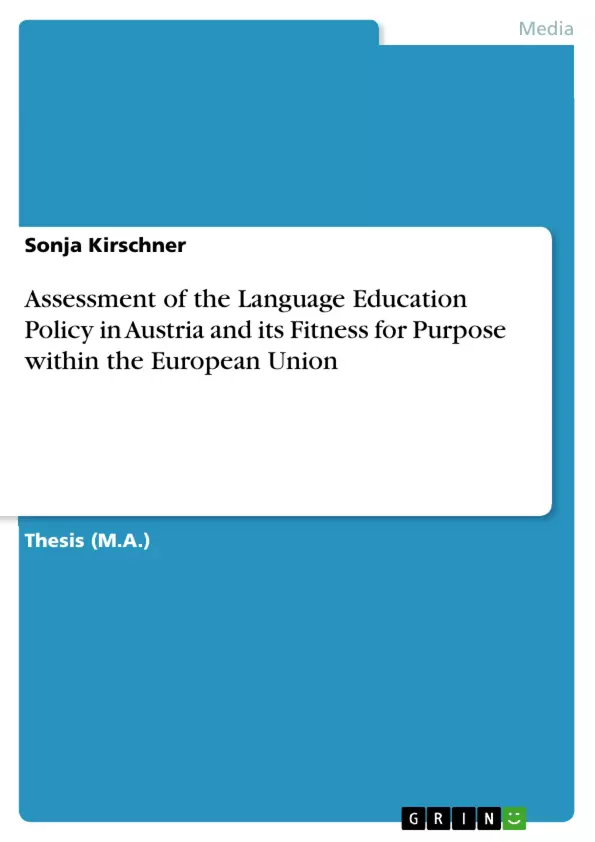Assessment of the Language Education Policy in Austria and its Fitness for Purpose within the European Union
The EU language policy, which is directly linked to the EU language education policy, has been constantly developing since the establishment of the EEC more than fifty years ago (Treaty of Rome, 1957). The Council Resolution of 31 March 1995 on improving and diversifying language learning and teaching within the education systems of the European Union made it clear that in language learning and teaching, as in education in general, the principle of subsidiarity applies. In this respect, this work examines the existing Austrian language education policy regulations and the country’s educational practices, in the light of the EU language education policy, focusing on the groups of Austrian nationals with German as their first language, non-indigenous minorities and Austria’s officially recognised autochthonous ethnic groups. The question of whether Austria adequately prepares pupils for the purposes of a multilingual social and economic interaction within the EU is equally considered. An up-to-date insight into the minority language education practice of a Burgenland-Croatian ethnic sample group is delivered, based on data obtained by self reporting questionnaires.
The analysis shows that the language education practice for all three groups can be largely regarded as a successful implementation of the current EU language education policy and, therefore, as an adequate preparation of pupils for live within the EU. The major deficiency of the most numerous groups of pupils is the fact that the learning of a second foreign language is usually introduced only at the upper secondary stage. With regard to the ethnic groups, the largest deficiency lies in the unavailable legal protection of the Minority School Acts to all groups. As the case study shows, this legal protection provides for a guaranteed, soundly balanced, mother tongue and German instruction at the kindergarten, primary and lower secondary school.
Table of Contents
- INTRODUCTION
- LANGUAGE EDUCATION POLICY (LEP) AND MULTILINGUAL DIMENSIONS OF THE EU
- The beginnings of the EU LEP
- Towards an inclusive LEP
- Multilingualism in the EU and Austria: Key facts and figures
- BACKGROUND INFORMATION ON THE GEOGRAPHIC POSITION, POPULATION, LANGUAGES AND EDUCATIONAL SYSTEM OF AUSTRIA
- Geographic position of Austria
- Demographic data
- Languages used informally by the resident population of Austria
- Educational system
- LEP REGULATIONS AND PRACTICE FOR AUSTRIAN NATIONALS WITH GERMAN AS THEIR FIRST LANGUAGE AND NON-INDIGENOUS MINORITIES
- The present situation of (foreign) language learning in pre-school education (ISCED level 0)
- The present situation of (foreign) language learning in compulsory schooling (ISCED levels 1-2)
- The present situation of foreign language learning in post-compulsory schooling (ISCED level 3-3/4)
- LEGISLATIVE FRAMEWORK AND LEP REGULATIONS/PRACTICE FOR THE OFFICIALLY RECOGNISED AUTOCHTHONOUS ETHNIC GROUPS OF AUSTRIA
- Legislative framework governing ethnic groups and their languages in Austria
- LEP regulations for the officially recognised autochthonous ethnic groups of Austria
- The present situation of minority language learning in Carinthia
- The present situation of minority language learning in Burgenland
- Case Study - Language education of the Burgenland-Croatian ethnic group of Nikitsch
- The present situation of minority language learning in Styria and Vienna
- CONCLUSIONS
Objectives and Key Themes
This dissertation explores the language education policy (LEP) in Austria and its effectiveness within the European Union. It examines the historical development of the EU LEP, the current situation of multilingualism in Austria, and the specific regulations and practices governing language learning for both Austrian nationals and officially recognized ethnic groups.
- The evolution of the EU LEP
- The role of multilingualism in Austria
- LEP regulations and practice for Austrian nationals
- LEP regulations and practice for officially recognized ethnic groups
- The impact of LEP on minority language learning
Chapter Summaries
This dissertation examines the language education policy (LEP) in Austria, exploring its effectiveness within the European Union. It investigates the historical development of the EU LEP, analyzes the current state of multilingualism in Austria, and delves into the specific regulations and practices governing language learning for both Austrian nationals and recognized ethnic groups.
Chapter 2 explores the genesis of the EU LEP, its progression towards an inclusive policy, and the multifaceted nature of multilingualism within the EU and specifically Austria. This chapter lays the groundwork for understanding the context of the study.
Chapter 3 focuses on Austria, providing a detailed overview of its geographic position, demographics, language use, and education system. This background information is crucial for understanding the factors influencing the country's language education policy.
Chapter 4 investigates the LEP regulations and practices for Austrian nationals, particularly concerning the learning of foreign languages in preschool, compulsory, and post-compulsory schooling. This chapter examines the implementation of the policy for the majority population.
Chapter 5 delves into the legislative framework and LEP regulations for officially recognized ethnic groups in Austria. The chapter focuses on the situation of minority language learning in various regions, with a case study highlighting the language education of the Burgenland-Croatian ethnic group of Nikitsch.
Keywords
The core concepts and themes explored in this dissertation include language education policy, multilingualism, European Union, Austria, ethnic groups, minority languages, and the impact of policy on language learning.
- Quote paper
- Sonja Kirschner (Author), 2010, Assessment of the Language Education Policy in Austria and its Fitness for Purpose within the European Union, Munich, GRIN Verlag, https://www.grin.com/document/265492



